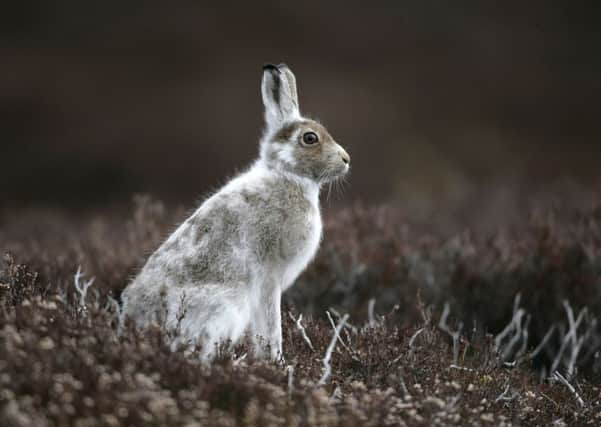Mass lobby at Scottish Parliament to protect mountain hares


The mass lobby has been organised by OneKind, the Scottish animal campaigns charity in support of greater protections for the mountain hare.
Scottish Green MSP Alison Johnstone, species champion for the hare, said: “The reports we’ve heard of mass culls of mountain hares, and the photos we’ve seen are deeply disturbing.
Advertisement
Hide AdAdvertisement
Hide Ad“The commercial interests of large sporting estates must not be allowed to trample over the conservation of highly valued wildlife.
“I hope Thursday’s rally outside Parliament helps put pressure on the Scottish Government to introduce greater protection for mountain hares, starting with a ban on culls in National Parks.
“To date the Government’s agency, SNH, has been ineffective in challenging applications for culls. The evidence is clear that culling hares does nothing to help the environment; it’s simply about an industry trying to maximise profits.”
Despite legal provisions that give the species conservation status, hare are regularly culled or commercially hunted in Scotland, even within our national parks.
The only estimate is that 25,000 were killed in 2006/7, which is thought to be between 5-14% of the total population.
Harry Huyton added: “The mountain hare is an iconic species in Scotland and the scale of persecution these creatures are subjected to is needless and completely inexcusable.
“OneKind is calling on the Scottish Government to provide more stringent protection for hares as an urgent priority, starting with a complete ban on hunting and culling in national parks.
“We hope politicians from all parties will attend the mass lobby on Thursday to hear the arguments in favour of greater protection of the hare and listen to their constituents views on this important animal welfare issue.”
Advertisement
Hide AdAdvertisement
Hide AdGrowing numbers of mountain hares are being culled outside of the agreed seasons in Scotland to prevent them causing serious damage to new trees.
The findings were revealed via a Freedom Of Information request to Scottish Natural Heritage (SNH) by The Scottish Gamekeepers Association (SGA).
In 2011, The Wildlife and Natural Environment Act introduced for the first time in Scotland a closed season to protect the mountain or ‘blue’ hare at vulnerable times of the year.
The Act made it unlawful to kill the species between March 1st and July 31st, unless under special licenses granted in ‘exceptional circumstances’ from SNH.
Conditions under which licences could be granted were to mitigate against disease and damage and only if the cull would not affect the hare’s conservation status.
Since the Act came into force in 2012, it has been revealed that all licences, enabling mountain hares to be culled year round in Scotland, have been signed off to prevent hares causing serious damage to young trees.
In the past three years, the number culled out of season for this purpose has also risen.
On top of the numbers culled to prevent grazing and browsing damage during the open season, applications for an additional 575 hares to be culled in the close season were approved in 2014 with a further 700 in 2015.
Advertisement
Hide AdAdvertisement
Hide AdUp to the end of March 2016, SNH had already granted licences for 838 hares to be controlled outside of the legal seasons on 5 sites in order to protect new saplings.
“Mountain hares are a fascinating species, largely because they change their coats to camouflage themselves against the winter snow. As with other herbivores, however, large numbers at one site are a proven threat to the establishment of young woodland,” said SGA Chairman Alex Hogg.
“Grants for new forestry are given on the basis that new stock must be protected from damage and we know mountain hare numbers in some areas of new woodland are having to be kept right down, all year round.
“In the past 25 years in the Cairngorms National Park, there has been approximately a quarter of a million acres given over to land use change to enable afforestation. With further ambitious targets for new tree planting schemes in Scotland, the use of out of season licences to suppress the numbers to enable tree establishment is likely to become the norm.”
The culling of mountain hares has become a hot subject, with animal rights groups blaming grouse estates for heavy culls to prevent disease and to minimise the spread of tick.
Of the 26 applications made to SNH for out of season licences up to March 2016, only two were related to aspects of grouse moor management, specifically heather damage and tick control.
Both of these licenses were refused by SNH.
SGA Committee Member Ronnie Kippen, a gamekeeper in Perthshire for 45 years, believes activists should be mindful of the consequences of their wishes.
He said: “In the 80s, before mechanised snow vehicles, there were two consecutive years where we couldn’t control the hare numbers because of heavy snow. In the spring of year 3, they died in their thousands, all over the hill, from intestinal parasites and it took five or six years for their numbers to come back again.
Advertisement
Hide AdAdvertisement
Hide Ad“If you don’t manage the population each year, you are looking at serious damage to habitats and dead hares lying everywhere rather than going back into the food chain. People might have good intentions but that is what will happen.”
